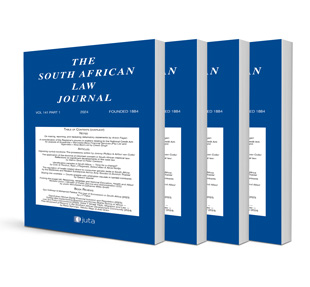Index

Index
Authors Lexinfo
ISSN: 1996-2177
Affiliations: None
Source: South African Law Journal, Volume 133 Issue 4, 2016, p. iii – xxxvii
Abstract
None

ISSN: 1996-2177
Affiliations: None
Source: South African Law Journal, Volume 133 Issue 4, 2016, p. iii – xxxvii
None

ISSN: 1996-2177
Affiliations: Former Justice of the Supreme Court of Appeal
Source: South African Law Journal, Volume 133 Issue 4, 2016, p. 939 – 941
None

ISSN: 1996-2177
Affiliations: University of Cape Town
Source: South African Law Journal, Volume 133 Issue 4, 2016, p. 936 – 939
None

ISSN: 1996-2177
Affiliations: University of Cape Town
Source: South African Law Journal, Volume 133 Issue 4, 2016, p. 933 – 936
None

ISSN: 1996-2177
Affiliations: None
Source: South African Law Journal, Volume 133 Issue 4, 2016, p. 931 – 932
None

ISSN: 1996-2177
Affiliations: Attorney, Phatshoane Henney Attorneys; Research Fellow, Department of Mercantile Law, University of the Free State
Source: South African Law Journal, Volume 133 Issue 4, 2016, p. 897 – 930
Appearance-based discrimination is a prevalent concern in workplaces worldwide. Employers’ subconscious appearance preferences seem to infiltrate their employment policies and practices, causing employees who do not meet certain appearance standards to suffer discrimination. Employers’ discretion to impose dress codes and grooming standards where such criteria are unrelated to the inherent nature of the job effectively curb employees’ right to freedom of expression, as well as their individuality and personal autonomy. Various jurisdictions have started enacting legislation to govern and outlaw appearance discrimination in the employment arena, and employees worldwide increasingly turn to judicial forums for relief in this regard. As South Africa still lags behind the rest of the world in dealing with this issue, this article attempts to contribute to the development of the law by exploring the concept of appearance prejudice in employment against the backdrop of unfair discrimination and equality principles in South Africa. The article further compares South Africa to the jurisdictions of the United States and the European Union, particularly the United Kingdom. I investigate whether appearance discrimination based on mutable (alterable) appearance characteristics currently enjoys sufficient recognition in South African law, whether it warrants protection and, if so, what forms of protection may be most relevant and effective.